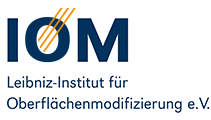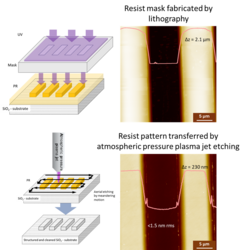As a key technology, photonics requires increasingly precise micro-optical elements with refractive and diffractive surfaces. Traditionally, these are produced by mask transfer or direct processing methods. Although microelectronic processes such as plasma etching, reactive ion etching (RIE), or ion beam etching (IBE) enable pattern transfer, they often rely on expensive vacuum systems and require special equipment.
Researchers in the Ultra-precision Surfaces research field at the IOM have now developed a cost-effective, sustainable dry etching process that transfers microstructures onto quartz glass using atmospheric pressure plasma jets (APPJ) – without the need for a vacuum. This innovative method has the potential to significantly reduce production time and costs and make the process more environmentally friendly.
In a recent project, the transfer of patterns from commercially available photoresist polymer masks to hard materials such as quartz glass was successfully tested using reactive plasma jets at atmospheric pressure. The result: a diffraction grating with a period of 15 µm, a depth of 230 nm, and a surface roughness of less than 2 nm RMS. In addition, important insights into etch selectivity, surface quality, and chemical modifications were gained.
These advances pave the way for the cost-effective, efficient, and environmentally friendly production of optical elements at atmospheric pressure. The method does not require aggressive chemicals or complex equipment, making it a sustainable alternative for microstructuring in photonics.
The results of the study were recently published in the journal Micro and Nano Engineering:
Stability of masking materials for pattern transfer of lithographic masks into fused silica by atmospheric pressure plasma jet etching
R. Heinke, L. Silhan, M. Ehrhardt, P. Lorenz, J. Zajadacz, J. Bauer, T. Arnold, M. Sery, K. Zimmer
Micro and Nano Eng. 28 (2025) 100309, DOI: 10.1016/j.mne.2025.100309

